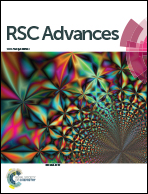TM atoms on B/N doped defective graphene as a catalyst for oxygen reduction reaction: a theoretical study†
Abstract
According to its high specific surface area and unique electronic properties, graphene with single transition metal atoms attached to defects in the graphene sheets is attractive for use in hydrogen fuel cells for oxygen reduction reaction on the cathode. It is motivated by the experimental observations for oxygen reduction reaction, and we use density function theory to systematically study the single transition metal atom-(B/N doped) vacancy complexes in graphene. The binding energies between single transition metal atoms and vacancies are calculated, along with adsorption energies of O2, OOH, HOOH, O and OH. Our results indicate that N-doping can effectively improve the binding strength of metal atoms with divacancies. According to the adsorption energies of oxygen reduction reaction intermediates, it is found that Fe–N doped divacancy, Co–N doped divacancy and Zn–N doped divacancy complexes are promising candidates for use in hydrogen fuel cell cathodes for oxygen reduction reaction.


 Please wait while we load your content...
Please wait while we load your content...